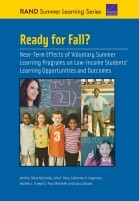| 来源类型 | Research Reports
|
| 规范类型 | 报告
|
| DOI | https://doi.org/10.7249/RR815
|
| ISBN | 9780833088178
|
| 来源ID | RR-815-WF
|
| Ready for Fall? Near-Term Effects of Voluntary Summer Learning Programs on Low-Income Students' Learning Opportunities and Outcomes |
| Jennifer Sloan McCombs; John F. Pane; Catherine H. Augustine; Heather L. Schwartz; Paco Martorell; Laura Zakaras
|
| 发表日期 | 2014
|
| 出版年 | 2014
|
| 页码 | 72
|
| 语种 | 英语
|
| 结论 |
Students Who Attended the Programs Entered School in the Fall With Stronger Mathematics Skills Than Those Who Did Not- Analyses suggest that students who attended class more often and received more instructional hours received the greatest benefit and performed best on the assessment.
The Programs Did Not Produce Near-Term Effects in Reading- It is possible a five-week summer program is insufficient to create measurable improvement in reading skills. Reading outcomes were not significantly affected even for students with the highest attendance and instructional hours.
- Our implementation analyses suggest that reading outcomes may be sensitive to classroom and site quality.These analyses found that treatment students who received higher-quality instruction, students who had a teacher with grade-level experience, and students attending an orderly site performed better.
The Summer Programs Did Not Affect Social and Emotional Outcomes- Treatment students did not receive higher social and emotional competence ratings from their teachers in the fall than control students received, although some district leaders hypothesized that their programs might have a positive effect on social and emotional outcomes.
Summer Learning Programs Appear to Serve Community Needs- We found strong demand among low-income students and their families for free, voluntary programs that combine academics and enrichment. Each district exceeded its expectations for applications, and the majority of accepted students attended the programs.
- Almost 60 percent of the control group, all of whom had applied to the districts' voluntary summer program but were denied admission, reported not attending any kind of summer program or camp over the summer. These families had all received targeted information on other summer recreation programs available in their communities.
|
| 摘要 |
- Districts interested in implementing summer programs may want to plan for programs that run five to six weeks and schedule 60–90 minutes of mathematics per day.
- Districts should make special efforts to promote consistent attendance, maintain daily schedules, and ensure teachers maximize instructional time inside the classroom.
- Districts may want to take particular care in selecting reading teachers for summer programming, trying to select the highest-quality reading teachers and those with grade-level experience (in either the sending or receiving grade).
- Establishing clear expectations for student behavior, ensuring consistent application across teachers, and developing methods of maintaining positive student behavior in class may pay off in terms of student achievement in reading.
- Districts may need to take specific actions in designing and executing summer programs if they wish to affect students' social-emotional outcomes in the near term.
|
| 主题 | Academic Achievement
; After-School Programs
; Disadvantaged Students
; Educational Administration
; Educational Program Evaluation
; Summer Learning
|
| URL | https://www.rand.org/pubs/research_reports/RR815.html
|
| 来源智库 | RAND Corporation (United States)
|
| 引用统计 |
|
| 资源类型 | 智库出版物
|
| 条目标识符 | http://119.78.100.153/handle/2XGU8XDN/107880
|
推荐引用方式
GB/T 7714 |
Jennifer Sloan McCombs,John F. Pane,Catherine H. Augustine,et al. Ready for Fall? Near-Term Effects of Voluntary Summer Learning Programs on Low-Income Students' Learning Opportunities and Outcomes. 2014.
|
|
文件名:
|
x1541074783267.jpg
|
|
格式:
|
JPEG
|

|
文件名:
|
RAND_RR815.pdf
|
|
格式:
|
Adobe PDF
|
除非特别说明,本系统中所有内容都受版权保护,并保留所有权利。